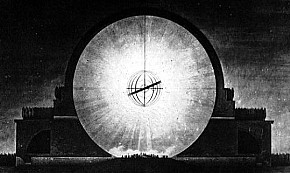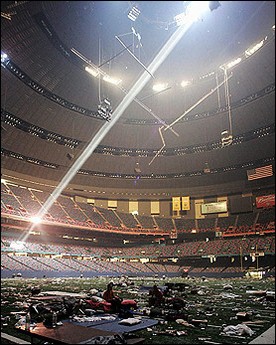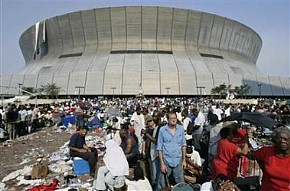2000.01.21
everything: Image and actuality
I was inspired by Hugh's last post to 'perform' a simultaneous riff.
I haven't been to Bilbao, but I've been to Sydney (didn't hear any Opera though). I'm not much of a critic when it comes to visiting buildings, because I inevitably like most of them once I see them in person. So it comes down to anecdotes. You can have an inexpensive lunch on the terrace-plinth of the Opera House overlooking the harbor. There are signs on the tables under umbrellas; they read: "Do Not Leave Your Food Unattended". The reason for this warning, and I've seen it happen, is that the moment you leave food on the table unattended, a small flock of sea-gulls will "attack" your lunch. Yikes! indeed.
The Opera House is really a nice sight from the harbor. While in Sydney, I stayed at Manly Beach (not making that name up), which connects to Sydney via ferry or hydrofoil. The Opera House is quite the landmark, and it looks really good at night as well.
I went to Australia purposefully not taking a camera. In the early 1980s I read Thomas Mann's Joseph and His Brothers, and very near the end of the book Mann writes a few lines about how there was no camera to capture incredible events throughout most of history, events like the reunion of Joseph and his brothers in Egypt. Mann simple said, "they had to use their own lenses." There are times when I now purposefully "use my own lenses", and my trip to Australia was one of those times.
I got to go to Canberra as well (this was early January 1987). I just happened to be there the day after the enormous flagpole was erected over the new Capitol. Well, as then installed, the flagpole looked straight from the front, but it was definitely leaning back by about 4 degrees when viewed from the side. To record that brief early history of the Canberra flagpole was the only time I wished I had a camera while in Australia.
Flying home, the pilot informed the passengers that Canberra was visible out the right side of the plane. I thought this would be real neat to see because of the huge circular geometrics of Canberra's urban plan. Well, I looked and I looked. I knew it had to be recognizable. Finally, there is was, the whole of Griffin's plan about the size of the hole in a piece of loose leaf paper. What a lesson in scale.
In the early 1980s, Aldo van Eyck was a guest chair at the University of Pennsylvania's Graduate School of Fine Arts. Van Eyck gave several lectures during the course of the semester. The first lectures was standing room only, but the rest became less and less attended--van Eyck talked for at least 3 hours each time, and there was lots of repetition. Anyway, this was just at the beginning of post-modernism's popularity within architecture, and van Eyck didn't like post-modernism at all. Basically, he wanted to continually prove that anyone interested in post-modernism didn't 'really' know architecture. He showed this slide of a detail of a fountain. You could tell it was historical, as opposed to modern, because of some flourish in the detailing. Van Eyck challenged the audience to guess where this detail came from; his point was that one really had to look at architecture to truly understand it. I should have answered out loud, but I only told the person next to me: "that's at the Taj Mahal." No one else answered, and finally van Eyck said, "it's at the Taj Mahal." My friend immediately looked at me and asked, "How did you know that?!?" I answered, "When I was something like 12 years old, I had a big jigsaw puzzle of the Taj Mahal in its classic view. I kind of know every inch of that place."
I have constructed a computer model of the Villa Savoye which I 'visit' occasionally, but I've never been there for real. The wife of an architect friend of mine tells a genuinely funny story about being there, however. When she and her husband were there, a group of other architects were there as well. Of course, all the architects had camera in hand, but it wasn't all that easy to take pictures. As Colleen stood in the background, she observed how each of the architects was gingerly walking around and taking snaps of the house while being careful not to get any of the other architects in their pictures or having themselves infringe upon anothers pictures. Colleen said it was one of the funniest things she ever saw. I said, "You should have taken a picture of that."
Personally, I don't think architectural photographers are as important as architects, mostly because architectural photography only presents a very narrow slice of the building's life, and especially a slice when all the 'makeup' is on and anything unsightly is literally out of sight. Are they mostly false pictures? Not necessarily, but the potential for falsehood is definitely there, and it's often a potential fulfilled in one way or another.
Perhaps I'm old fashioned, but the architectural images I enjoy (and learn from) the most are the fine line drawings and engravings, be they plans, elevations, sections, perspectives, that are largely a product of the nineteenth century. That's why most of the architecture books I buy now are purchased through eBay.
| |
2002.01.21 17:11
Re: plain guantanamo
One would hope that the cells at guantanamo are the best in temporary design. Temporary design (or really the design of something temporary) usually incorporates efficiency, but does not necessarily incorporate good design. In this case, the goodness might be best judged by just how temporary the design is, meaning it would be best not to have to have this design at all.
030121a Acropolis Q site plan
3392ii01
030121b Ottopia base map 2
2226i11
2004.01.21 18:16
best thing about new jersey
The second most incredible building of the 20th century is just off New Jersey's southern tip.
2004.01.21 18:32
best thing about new jersey
The W.W.II bunker that was originally 700 feet inland and now 30 feet up in the air on a forest of pilotes in the ocean--an uncanny manifestion of the Le Corbusian paradigm.
2007.01.21 18:32
Museum Exhibitions (MOCA's Skin + Bones)
"When Dutch architects Ben van Berkel and Caroline Bos (www.unstudio.com) said "Architects will be the fashion designers of the future," were they really saying something that at base is unethical in terms of it's promotion of planned obsolescence, or were they (correctly?) predicting that architects will soon be the consummate designers of all things that purposefully do not last?"
"Maybe a concerted effort to separate design from fashion is design's real next challenge."
--A Quondam Banquet of Virtual Sachlichkeit: Part III, p. 82.
| |
SW: unity/harmony requires, ironically, that those you would put in the same 10m space together actually have to deal with each other without finding an easy way to separate themselves or make a distinction based on the space.

2008.01.21 09:46
design to symbolise "religious harmony"
 
| |
14012101 Frug House 1 scan site plan plans sections elevations to scale
220ai02
14012102 Frug House 2 scan site plan plans sections elevations to scale
220bi02
14012103 domestic architecture plans layers 1-99
2080i21
14012104 domestic architecture plans layers 1-19
2080i22
14012105 domestic architecture plans layers 20-39
2179i05
14012106 domestic architecture plans layers 40-59
2248i03
14012107 domestic architecture plans layers 60-79
2306i10
14012108 domestic architecture plans layers 80-99
2404i01
15012101 IQ03 streets/blocks opaque GAUA plans IQ06 streets/blocks plans
2177i32
15012102 IQ03 model base
2392i98
15012103 Customs Offices model GAUA
2122i05
15012104 Villa Rotunda GAUA 1100x550
2080i45
16012101 OMA Cai Guo Qiang Studio Expansion
17012101 BIG Museum Centre Blaavand
|



